Affiliate disclosure: This post may contain affiliate links. Please see our Privacy Policy.
Poisonous Berries can cause intense symptoms, and some can even be fatal. Learn these common toxic berries and fruits to avoid when out foraging wild edible plants.
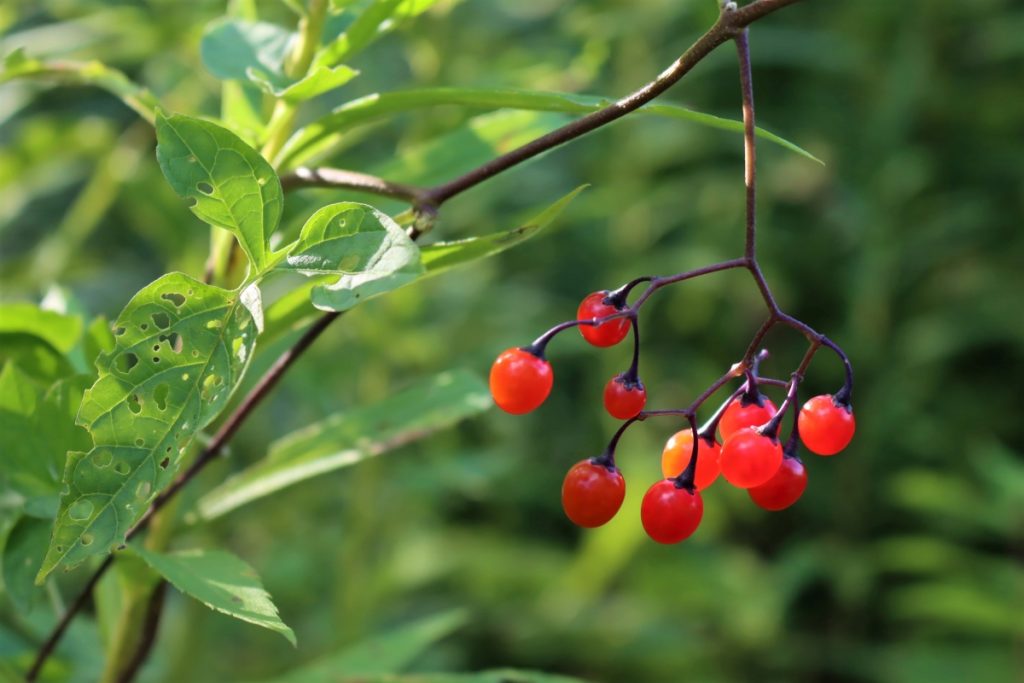
Table of Contents
- Baneberry, Red (Actaea rubra)
- Baneberry, White (Actaea pachypoda)
- Bittersweet, American & Oriental (Celastrus sp.)
- Belladonna (Atropa bella-donna L.)
- Cotoneaster (Cotoneaster sp.)
- Elderberry (Sambucus Nigra)
- European Spindle (Euonymus europaeus)
- Holly Berry & Winterberry (Ilex sp.)
- Lily of the Valley (Convallaria majalis)
- Mezereon or February Daphne (Daphne mezereum)
- Mistletoe, American (Phoradendron leucarpum)
- Moonseed (Menispermum canadense)
- Nightshade, Bittersweet (Solanum dulcamara)
- Poison Sumac Berry (Toxicodendron vernix)
- Pokeweed Berry (Phytolacca decandra)
- Snow Berry (Symphoricarpos sp.)
- Virginia Creeper (Parthenocissus quinquefolia)
- Yew Berry (Taxus sp.)
- Foraging Guides
Every summer I spend countless hours foraging wild edible berries in the woods and fields around my home, and at this point, I know most of them like old friends.
There are plenty of poisonous berries or potentially toxic fruits growing nearby too, but up until now, I’ve not spent much time learning to identify those species. In truth, it’s just as important to know how to identify toxic berries and fruit as it is to know the edible ones.
I’ve started this as a list of poisonous berries I’ve come across, both in the wild and discussed online. I’ll keep adding to it as I find new species common to the US, especially those that have edible look-alikes.
This is by no means an exhaustive list, but more of a starting point in the discussion. If you know of any common species that I’ve missed, please do leave me a note in the comments and I’ll work on adding them.
Eventually, I’d love for the list to be as comprehensive as possible.
While everything listed here is toxic to some degree, they may not all be berries from a purely technical standpoint. Poisonous fruit or poisonous seeds might be a better title, but you get the idea.
(As always, never attempt to consume wild plants without being 100% sure of your identification, both ruling out the potential toxic look likes and positively IDing the plant. I’ve listed as many as I can find, but this isn’t an exhaustive list. Just because you don’t see it below doesn’t mean it’s edible…)
Baneberry, Red (Actaea rubra)
Two main species grow throughout North America, but red baneberry (Actaea rubra) is perhaps the one most commonly encountered by hikers. Red baneberry is known by several names, including snakeberry, western baneberry, and red cohosh.
Red baneberry commonly grows throughout most of the US and Canada. (Range Map)
The plants are herbaceous perennials that appear in the spring from a basal stem structure. In the fall, it dies back to the ground. Most of the bushes grow up to three to five feet tall.
This poisonous berry plant is identifiable by long roots, feathery saw-toothed leaves with a fuzzy underside. Throughout May and June, small, fragrant white flowers appear; the plant is beautiful in full bloom. At the end of the summer, those white flowers turn into clusters of red berries.
The most common side effects from eating red baneberry are dizziness, stomach cramps, headaches, vomiting, and diarrhea. Experts believe that eating only six berries could lead to respiratory distress or cardiac arrest. This is incredibly concerning when it comes to children who love to eat handfuls of berries.
In North America, there are no reports of baneberry causing any death to humans or livestock (yet). The European species have fatally poisoned several children.
In most cases, people only eat a single berry because it causes your mouth and throat to burn along with a nasty, bitter flavor. Birds and animals love the berries; let’s leave these poisonous berries to them.
Similar Edible Species: Solomon’s Plume (Maianthemum racemosum) is a possible similar edible species to red baneberry. In the spring, the plant has large masses of small, white flowers that turn into clusters of ruby-red berries. Looking at the leaves is the easiest way to tell these species apart.
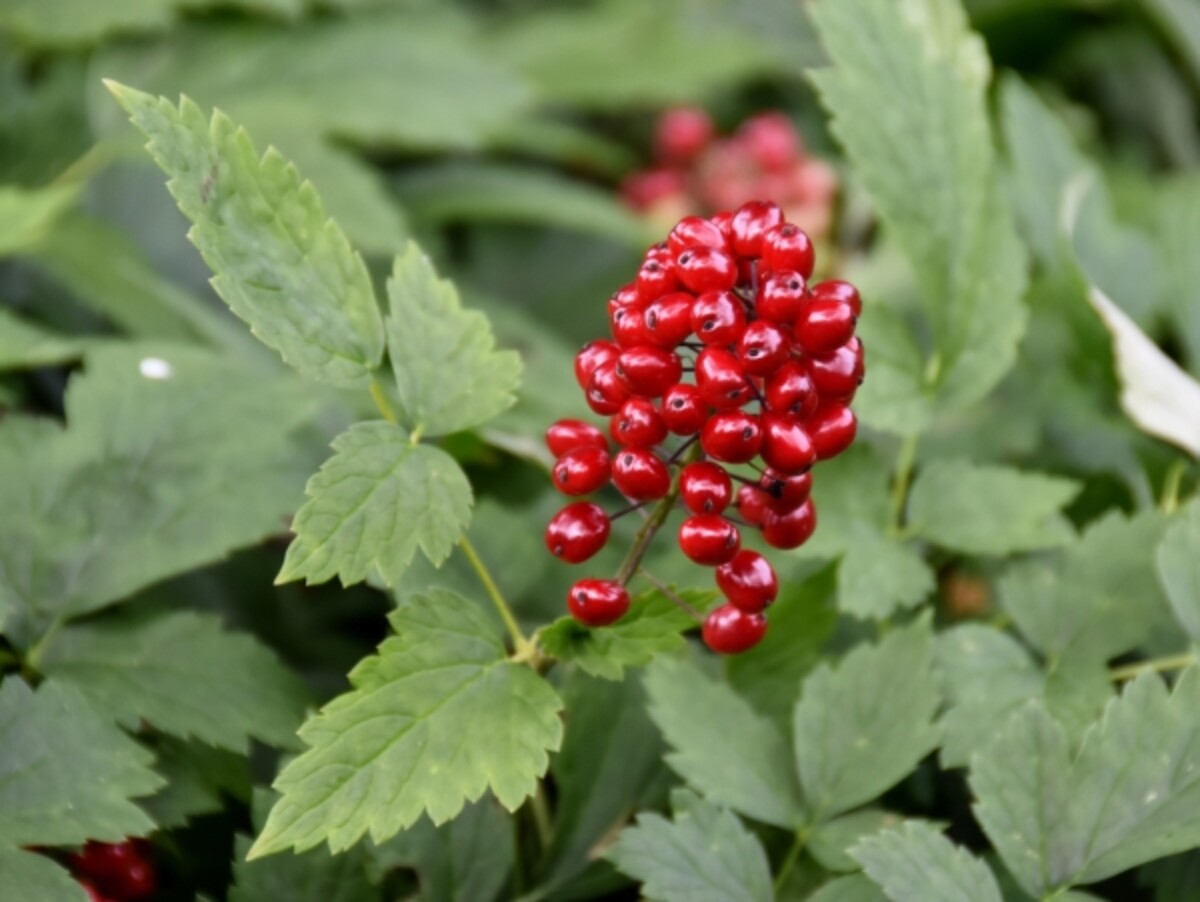
Baneberry, White (Actaea pachypoda)
Also known as “dolls eyes,” white baneberry is a poisonous berry native to North America spanning from the Midwest to the Eastern US and Canada (Range Map).
The berries are white with black dots, which explains the common name as they actually look like plastic doll eyes.
Similar Edible Berries: None. Dolls’ eyes are really distinctive, and they’re really only a risk to children who may wish to play with them. They’re low growing, the perfect height to be found by young hands.
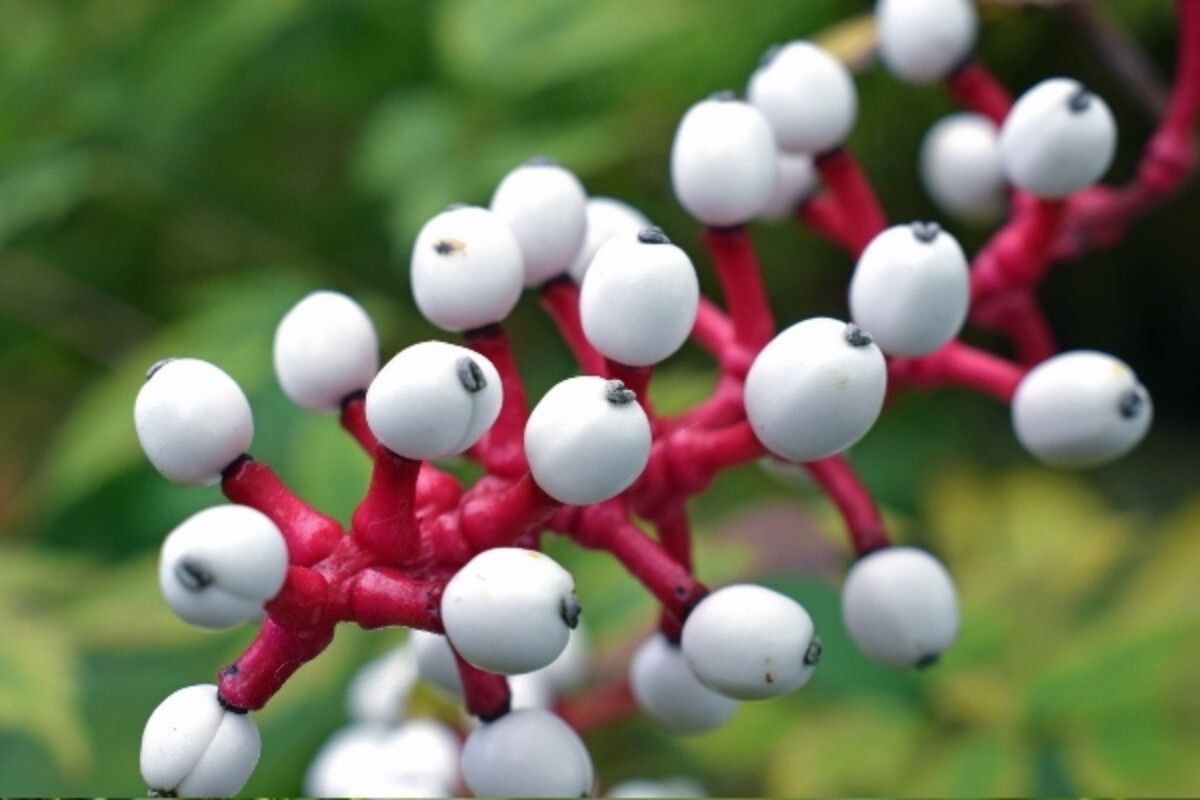
Bittersweet, American & Oriental (Celastrus sp.)
Also known as Climbing Bittersweet, False Bittersweet, Climbing Orange-Root, Fever-Twig, Fever-Twitch, Staff-Vine, Jacob’s-Ladder. American Bittersweet (Celastrus scandens) is native to North America and spanning the US and Canada with the exception of the Westernmost regions (Range Map).
The plants are conspicuous and incredibly beautiful, providing an exotic touch to an otherwise green/brown native landscape. I first came across them when I was foraging hickory bark to make syrup, and the bright berries were unmistakable in the fall landscape.
The berries are toxic to humans and all parts are reported to be poisonous, causing vomiting and diarrhea.
The fruits are eaten by all manner of wildlife, from songbirds to squirrels. While it is a native wild berry, it’s declining due to its use in floral arrangements and decorations.
To produce berries, American bittersweet requires both male and female plants in close proximity for cross-pollination, so it’s possible that it exists in the landscape without much notice.
Oriental bittersweet (Celastrus orbiculatus) is popular in landscape plantings and has a similar appearance. If you’re curious, this guide will help you tell the difference between the two bittersweet species.
(They’re both toxic berries in any case.)
Similar Edible Species: There’s nothing that looks quite like bittersweet, so it’s unlikely to be confused with an edible species. There are other bright orange edible fruits, namely sea buckthorn (Hippophae rhamnoides) and firethorn (Pyracantha sp.), but both are bushes rather than vines and neither has a pod around the fruit. Wild Husk Cherries (Physalis sp.) have orange fruit with a husk, but it’s papery and thin, and they grow on herbaceous plants (not perennial vines).
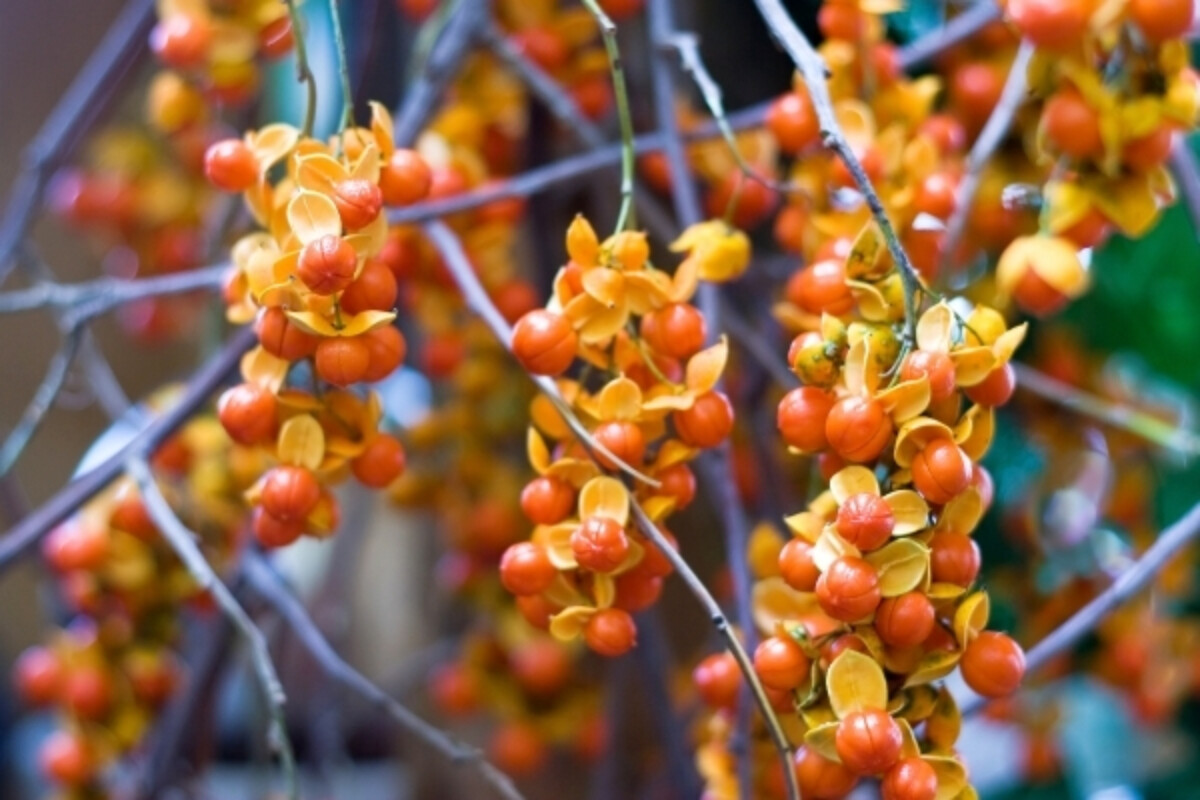
Belladonna (Atropa bella-donna L.)
Belladonna means “beautiful woman” in Italian. This plant is also known as Deadly Nightshade. The nightshade family of plants includes tomatoes, eggplant, potatoes, tobacco, and chili peppers. Belladonna has tubular-shaped flowers that produce black, purple, or lavender berries.
Belladonna is native to Eurasia and introduced to North America spanning the West Coast of the US and a few states in the Northeast. (Range Map)
All parts of the plant contain tropane alkaloids. It is especially dangerous for children because of the appearance of the berries and sweet taste. Consuming 2-5 berries could kill an adult human.
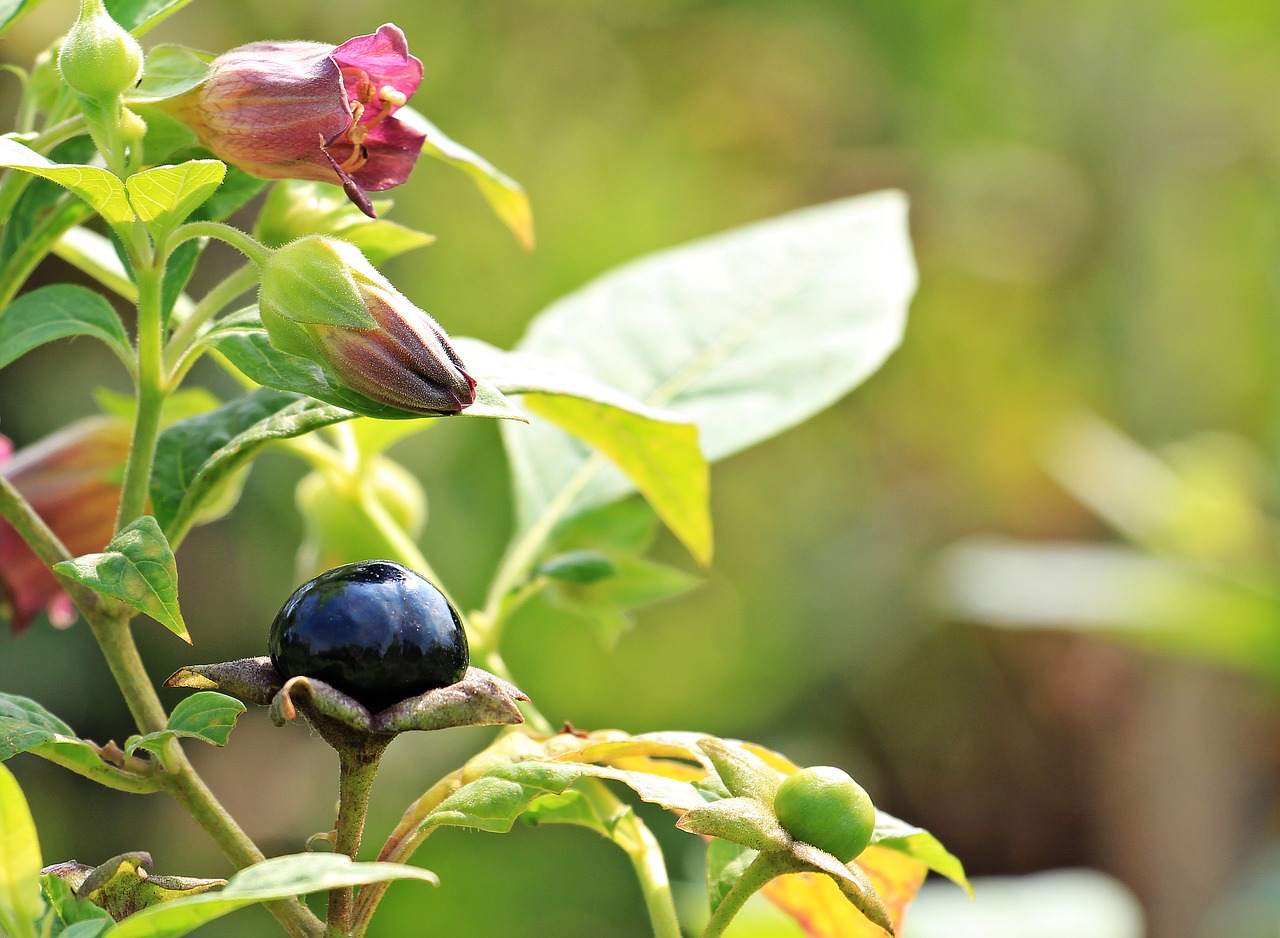
Symptoms of belladonna poisoning include dilated pupils, sensitivity to light, dry mouth, headache, dizziness, drowsiness, vertigo, loss of balance, blurred vision, confusion, tachycardia, hallucinations, acute psychosis, and convulsions.
I’ve also yet to see this one in the wild, though it’s supposed to be quite common. I usually see other toxic nightshades, namely Bittersweet Nightshade (Solanum Dulcamara).
Similar Edible Species: There are actually a number of edible nightshades, and some of the cultivated (and wild) edible species look just like these. Seed catalogs sell them under names like “wonderberry” or “garden huckleberry,” and they’re very similar to toxic nightshades.
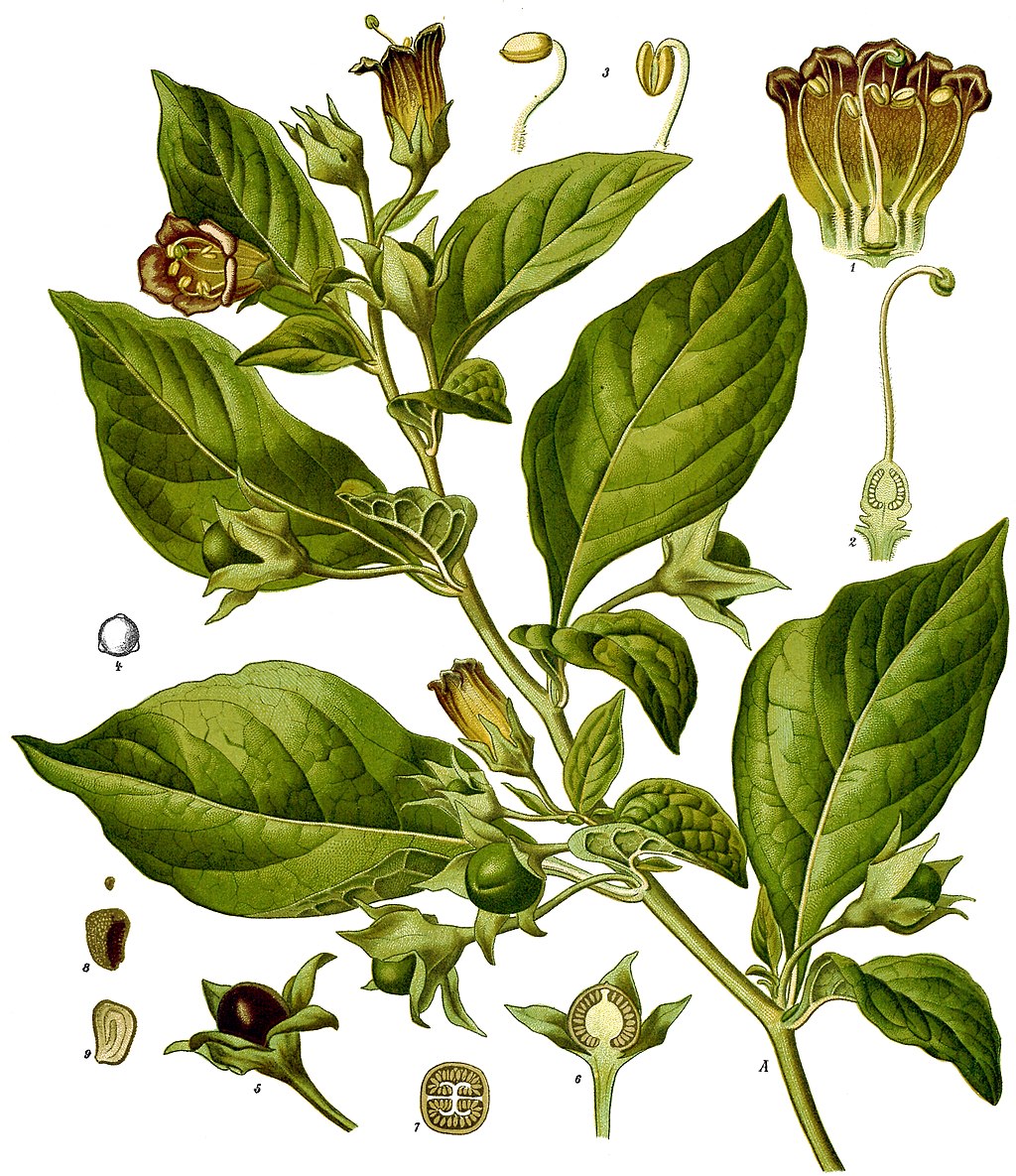
Cotoneaster (Cotoneaster sp.)
Cotoneaster belongs to the Rosaceae family. A few other names that it’s commonly called include Rock Cotoneaster and Rockspray Cotoneaster. It’s native to China, but it loves cooler climates and temperate regions. This plant grows well in USDA zones 4-9. In some areas, it’s becoming invasive. (Range Map)
Cotoneaster species are generally shrubs varying in size, some growing as tall as 25 feet. It’s a deciduous shrub with tiny, rounded leaves that are glossy and green throughout most of the year. In the fall, the leaves change to bright shades of red and orange.
In the spring months, pink flowers appear across the shrub. The flowers dot across the branches evenly, not in clusters. Over time, the flowers fade with small berries developing in their place. The fruits start yellow but turn to a bright, scarlet color.
California lists Cotoneaster as a level 4 toxic plant. That means ingesting any parts of the plant might affect your heart, liver, kidney, or brain.
Its high toxicity levels are because the leaves, berries, and flowers contain cyanogenic and glycosides. When the parts of the plant are ingested, the digestion process turns this to cyanide. However, to cause severe symptoms, adults need to consume large amounts. The risk is highest for children and pets.
Kids younger than six years old are the most likely to take a bite from a Cotoneaster; several poisonings happen each year. Make sure to check your yard and property for any of these poisonous berry plants.
I’ve yet to run across this one in the wild, but I’ve read they’re quite common since they’re popular landscape plantings. The birds spread the seeds and they’re liable to pop up anywhere.
Similar Edible Plants: Firethorn Berries (Pyracantha sp.) is a plant that looks similar to Cotoneaster plants. The plants produce pink flowers and bright, red berries. If you need to tell them apart, Pyracantha shrubs have tons of thorns, while Cotoneaster is thornless. They also look a bit like red aronia, with a puckered end of the fruit.
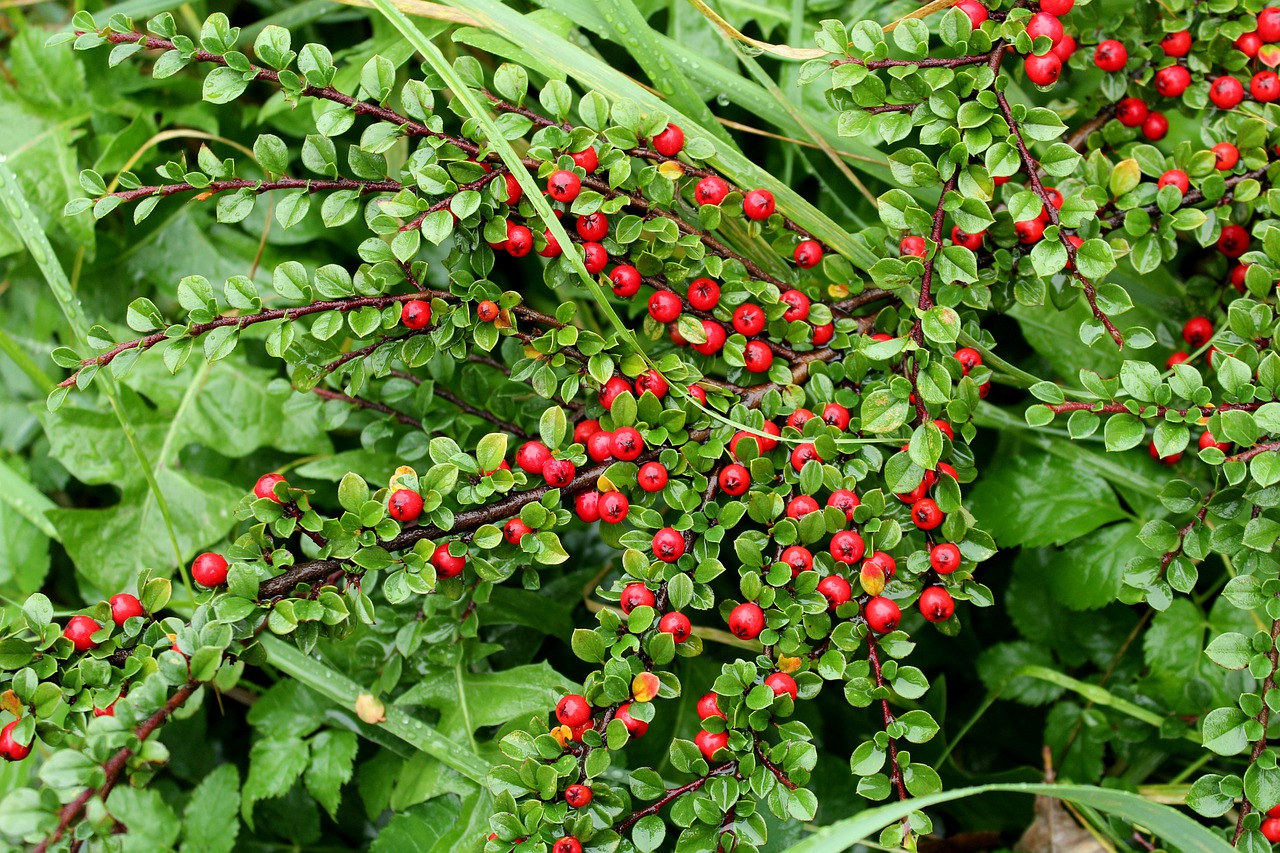
Elderberry (Sambucus Nigra)
Also know as Black Elderberry, Elder, or Common Elder, Elderberries are delicious wild edibles and potent medicine, but they’re potentially toxic when raw. There is one well-known case where a large group of people at a party were poisoned after drinking a punch bowl full of raw elderberry juice.
Toxic symptoms from raw elderberries include nausea, vomiting, abdominal cramps, and diarrhea.
That said, it seems to affect different people in different ways, and some experience no ill effects. Still, it’s better to be safe than sorry, and always cook elderberries.
We make elderberry pie every fall, and my kids absolutely love elderberry gummies, but both involve cooked fruit.
The berries are also medicinal and have been shown to boost immune function and shorten the duration of cold and flu-like illnesses. We make homemade elderberry syrup and elderberry tincture to store this medicine for winter use.
Though the fruits are edible when cooked, all other parts of the plant are toxic regardless. The stems, leaves, and roots are poisonous to humans.
Black Elderberry is native to North America spanning nearly all of the US and Canada (Range Map).
Similar Edible Species: Elderberries are edible when cooked, so this really should read “other elderberry look-alike species.” I’ve seen people confuse Nannyberry (Viburnum Lentago) and Aronia (Aronia melanocarpa) with elderberry in plant identification groups on occasion. Both have a bushy growth habit and clusters of black fruit, and they’re both edible when raw.
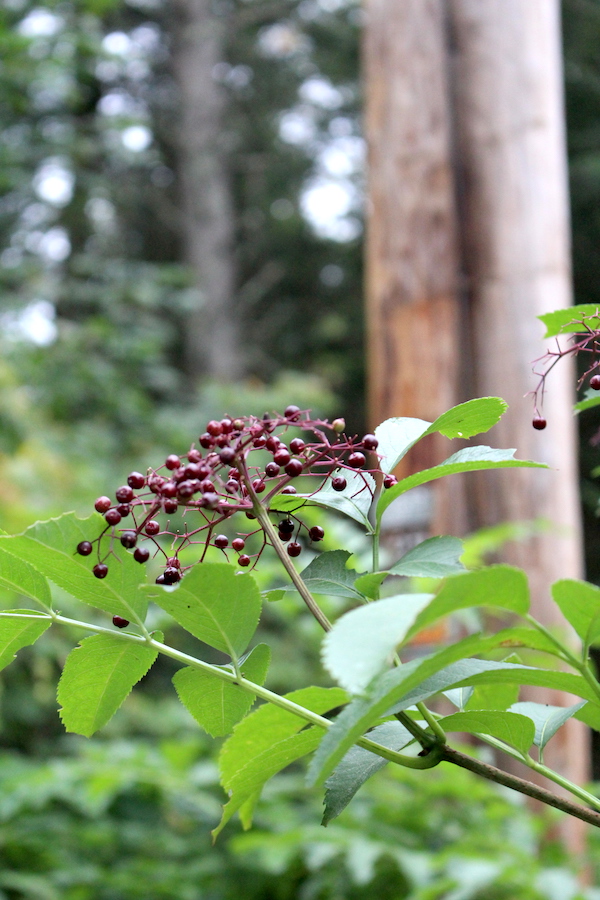
European Spindle (Euonymus europaeus)
European Spindle is a deciduous plant that looks like a small tree or a large shrub. It’s mostly known as the European Spindle because the stems are hard and often used as weaving spindles. However, other common names include prick timber, prickwood, and spindleberry.
This shrub is found all over Europe, but it also grows in North America. (Range Map)
Pink fruit capsules form all over the shrub, eventually splitting and revealing bright orange berries. The contrast of the pink and orange against the green leaves is quite beautiful, which is why it’s an ornamental plant in many locations.
To me, they look like tiny pumpkins hanging from the branches before they pop open, and I was curious enough to pocket a few to identify them at home. Kids, of course, might just try this crazy pumpkin fruit right off the tree.
Children are the most vulnerable when it comes to these poisonous berries. The trees often are located in parks, attracting the attention of little kids.
European Spindle berries contain several poisons, including glycosides, evobioside, evomonoside, and evonoside. Thirty berries are a fatal dose for adults, but for children, the amount is much lower.
Symptoms of poisoning from a European Spindle plant include nausea, dizziness, stomach pains, vomiting, and diarrhea. In serious situations, indigestion might cause unconsciousness, kidney failure, or death. Most symptoms appear 10-12 hours after ingestion.
Similar Edible Berries: European Spindle is unique and identifiable. The berry capsules stand out amongst other plants.
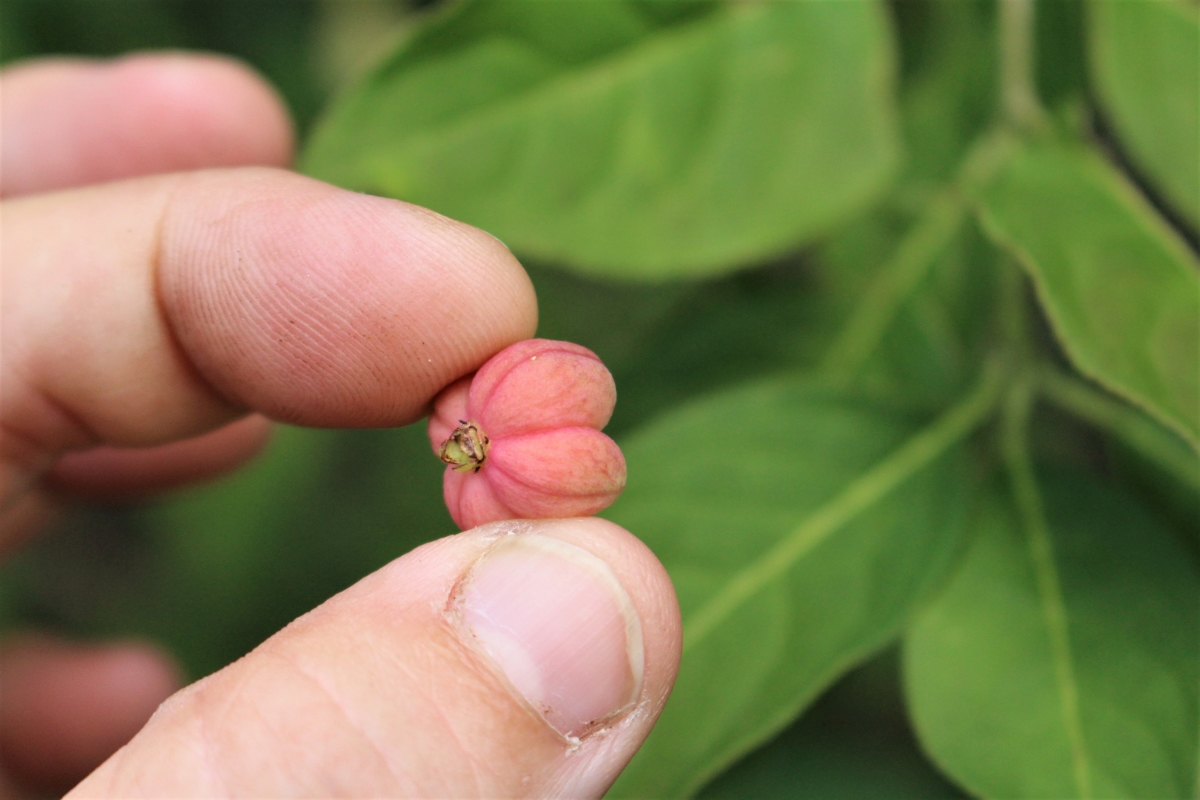
Holly Berry & Winterberry (Ilex sp.)
American Holly (Ilex opaca), also known as Christmas Holly or Yule Holly is native to the lower 48 states spanning from the Midwest to the Eastern US (Range Map). Winterberry (Ilex verticillata) is native to the Eastern half of the US and Canada (Range Map).
Both have bright red berries that persist well into winter. The fruited branches of American holly, in particular, are a very popular Christmas decoration, though winterberry is sometimes used as well.
The berries are thought to be poisonous to humans but are eaten by other mammals, game birds, and songbirds.
Winterberry is considered only mildly poisonous and was used medicinally by native peoples. They induce nausea and low blood pressure if eaten.
For American Holly, toxicity can vary based on the season, the parts ingested, and also the plant’s stage of growth. The sensitivity to the toxin can also depend on the person’s age, weight, physical condition, and individual susceptibility. I’ve read that holly leaves can be used to make tea, but really, I’d say it’s not worth playing around with any plant in the Ilex genus.
Similar Edible Species: The bright red berries born closely along the stems of these plants are pretty distinctive, and I honestly can’t think of anything similar. If you know of an edible berry with a similar appearance, please do leave me a note in the comments.
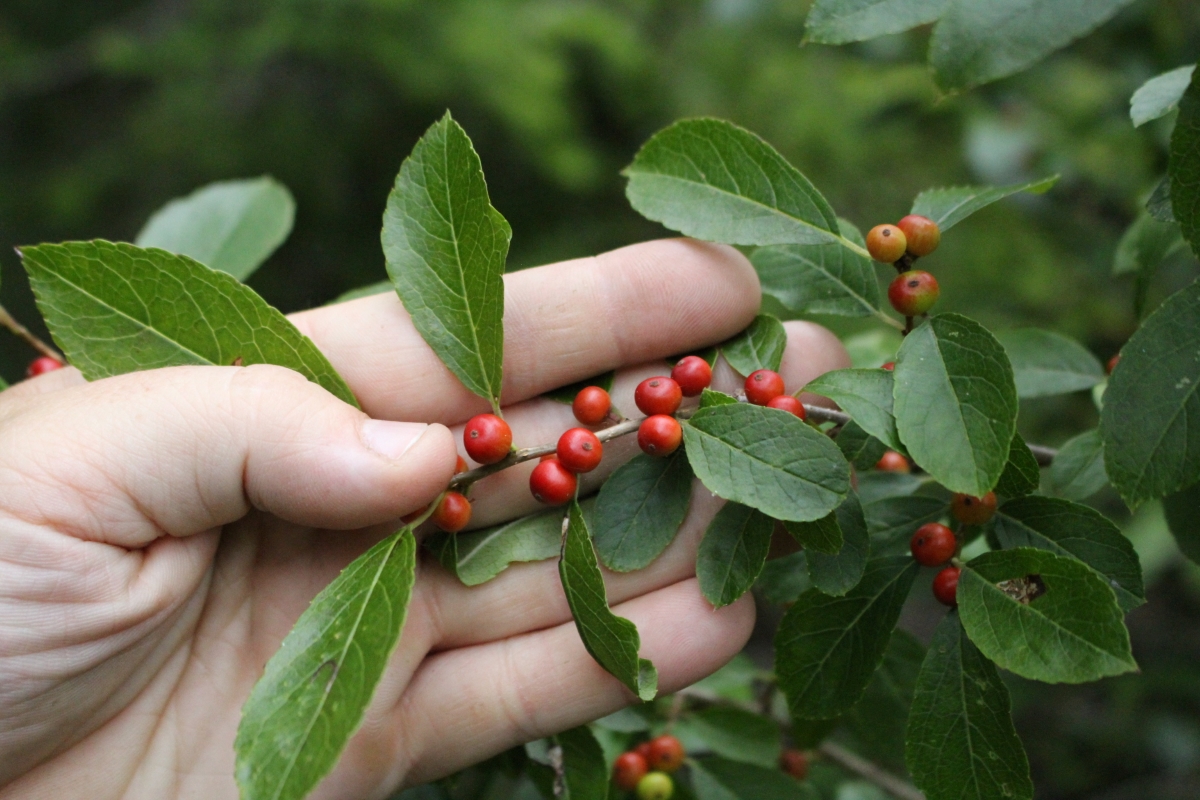
Lily of the Valley (Convallaria majalis)
Lily of the Valley is a very popular plant for gardeners and is also used in cut flower arrangements in the floral industry. It is native to the lower 48 states spanning a portion of the Eastern US (Range Map).
Lily of the Valley isn’t really present much in the Northeast, but they play a key role in the plot of the series Breaking Bad, which is where I came across them.
All parts of the plant are poisonous, especially the red berries which can be very attractive to children. A small amount can cause abdominal pain, vomiting, confusion, fatigue, and reduced heart rate. Around 38 different cardiac glycosides have been found in lily of the valley that can lead to cardiac arrest (heart attack) and death. The plant can also be harmful for dogs, cats, and horses.
Though it is a poisonous berry, it’s also a common landscape plant and commonly available at nurseries.
Similar Edible Species: The plant produces bright red berries close to the ground, which are superficially similar to some Maianthemum species, namely Canadian Mayflower (Maianthemum Canadense) and False Solomon’s Seal (Maianthemum racemosum). If you’re really reaching, you might say include other low-growing edible red berries, such as partridgeberry or wintergreen, but none are really all that similar to Lily of the Valley.

Mezereon or February Daphne (Daphne mezereum)
Commonly known as Paradise Plant, Mezereum, February Daphne, Spurge Laurel or Spurge Olive is a dense rounded shrub, very fragrant flowers in pink to lilac or white blooming in early spring, small red fruit appear later in summer.
It’s one of the earliest spring pollen sources for the bees, blooming even before coltsfoot. The smell is absolutely intoxicating, and a gentle spring breeze lets me know they’re blooming at the edge of the woods on our land. They love shady wet soils, which we have in abundance.
Toxic compounds of mezerein and daphnin are present in both the berries and twigs. Symptoms start with a choking sensation including burning and tingling sensation in mucous membranes of mouth, throat, and stomach followed by headache, nausea, abdominal pain, and diarrhea. Contact with sap causes blistering and swelling.
Eating 1 or 2 berries can cause an upset stomach in adults and ingesting more can be fatal.
Native to Europe and Siberia. Introduced to North America spanning the upper Eastern US and Canada as well as Alaska and Montana. (Range Map)
While I often find them in the wild, I’ve also seen them at plant nurseries and they’re common shade shrubs planted against the houses in the nearby suburbs.
Similar Edible Species: Potentially anything with red berries, but honestly, I can’t think of really anything edible that looks like February Daphne.
The picture is of the early spring flowers for now, I’ll add in the bright red berries later when they emerge in the late summer/fall.

Mistletoe, American (Phoradendron leucarpum)
American Mistletoe is also known as Oak Mistletoe, Hairy Mistletoe, Eastern Mistletoe, and False Mistletoe is the mistletoe that is commonly used for decoration at Christmas in the US. It is a semi-parasitic shrub growing on trees. The flower is inconspicuous and produces a white berry.
The berries are covered with a sticky substance that is poisonous to humans but loved by birds. Symptoms include stomach and intestinal irritation with diarrhea, vomiting, difficulty breathing, lowered blood pressure, and slow pulse.
Native to North America spanning the Midwest to Eastern US (Range Map)
(Another species known as European Mistletoe (Viscum album) is native to Europe and is also toxic.)
Similar Edible Species: None that I know of.
Moonseed (Menispermum canadense)
Moonseed also called Common Moonseed, Canadian Moonseed or Yellow Parilla is named after the shape of the seed which looks like a crescent moon. Grows in moist woods, thickets, and stream banks. It is a climbing vine with small, greenish-white flowers. Fruit ripens in September and is blue to black in color with a whitish-powdered bloom.
Native to Canada and the US spanning from the Midwest to Eastern US and Canada (Range Map)
All plants are poisonous, and there have been reported deaths as a result of eating Moonseed. It supposedly has a rank taste that’s unpleasant, which in theory should stop children from ingesting it…but that’s not always the case.
The vining plant looks just a bit like wild grapes, with large vaguely grape-ish leaves and clusters of fruit. The resemblance is only slight if you’re looking closely, but it could be a problem if you’re harvesting wild grapes quickly without paying attention (or with children helping).
Seeds of moonseed are crescent-shaped, thus the name, while the seeds of wild grapes are round.
Similar Edible Species: This honestly looks an awful lot like wild grapes, and it’d be easy enough to confuse them if they were vining together and you weren’t paying attention. I haven’t actually seen these in the wild (yet), but I’m always on the lookout.
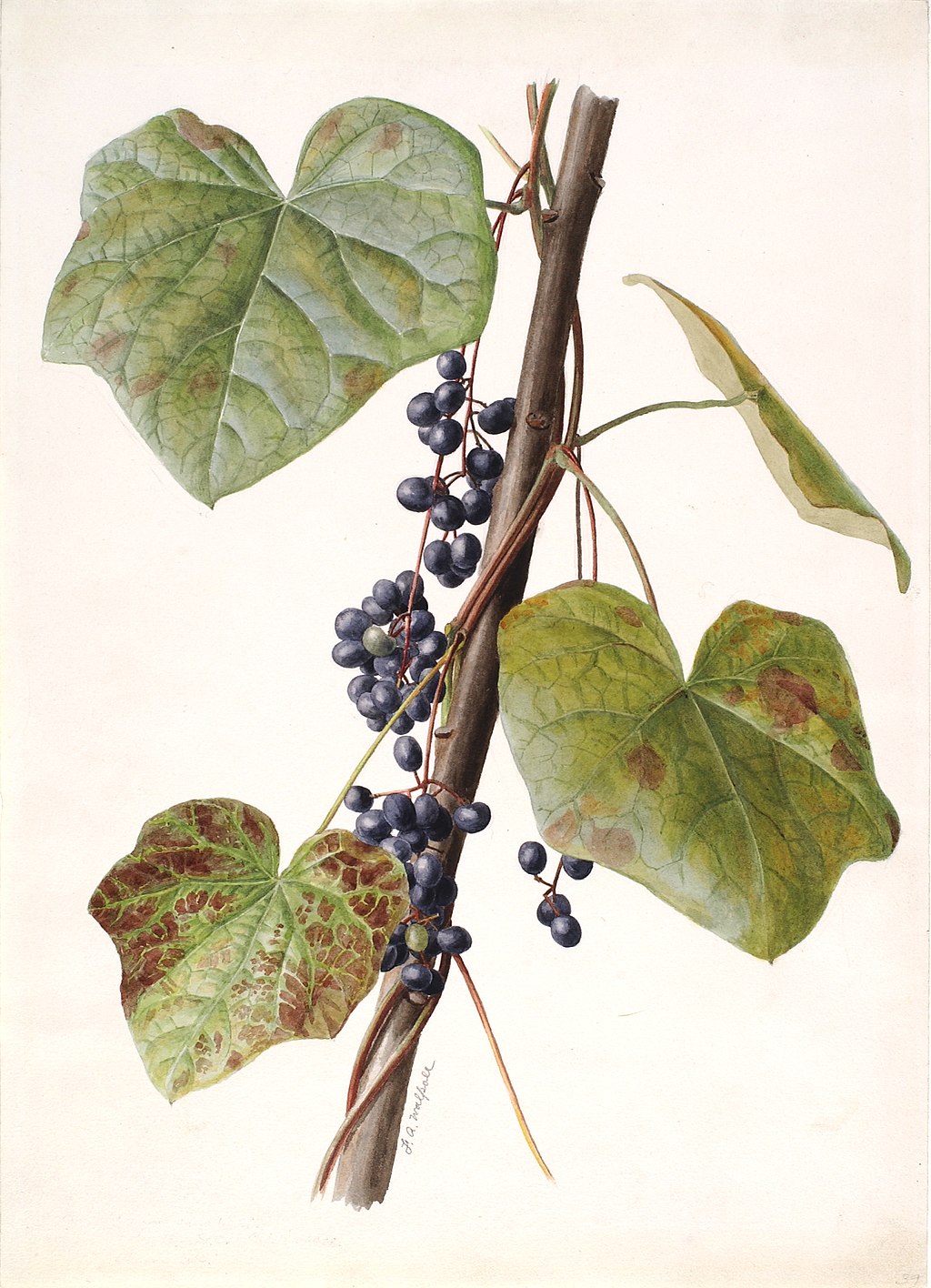
Nightshade, Bittersweet (Solanum dulcamara)
Bittersweet nightshade is a vining species in the Solanaceae family. Some of the common names you might recognize are bittersweet, bitter nightshade, scarlet berry, trailing bittersweet, and woody nightshade.
It’s native to Europe and Asia, but it’s naturalized throughout a majority of North America. You can find it in most states except for southern states, Alaska, and Hawaii. (Range Map)
Bittersweet nightshade is a perennial vine or semi-woody shrub that loves to grow near creeks, wetlands, field edges, and roadsides.
This plant has leaves that are dark green to purple-tinged. From May to September, bittersweet nightshade produces star-shaped, purple flowers with stamens and a prominent yellow cone. After the flowers fall off the plant, round or egg-shaped berries appear, starting as green and ripening to a bright red.
All parts of the bittersweet nightshade plant are poisonous to people, pets, and livestock. It’s important to note that this isn’t the same plant as the deadly nightshade or belladonna. It’s not as poisonous, but it has caused the loss of pets and death in children who eat the berries.
In general, bittersweet nightshade has a nasty scent that causes animals to avoid eating it. This plant contains solanine, which is the toxin also found in other members of the nightshade family. Keep your family and pets clear of this plant.
Similar Edible Berries: Bittersweet nightshade looks similar to highbush cranberries, though highbush cranberry contains one large seed (and bittersweet nightshade has many small seeds, like a tomato). To make it more confusing, it’s not unusual for this plant to vine up in highbush cranberry shrubs. I’ve actually found the berries vined together, and ripe at the same time.
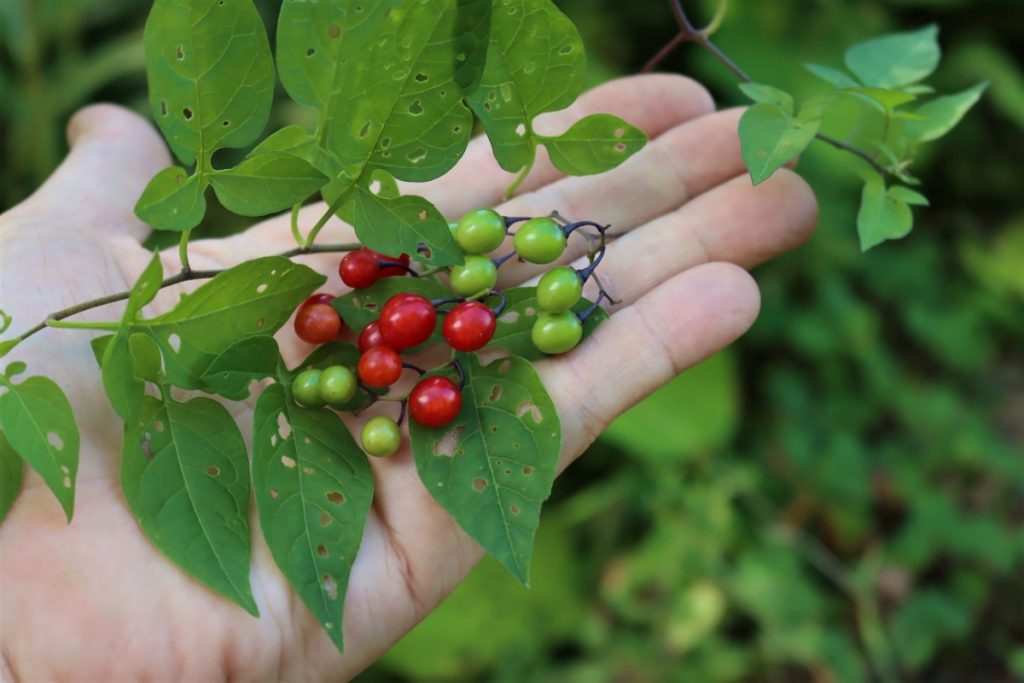
Poison Sumac Berry (Toxicodendron vernix)
Poison Sumac is a plant that grows throughout North America, cousin to the better-known poison ivy. These small trees reach up to 30 feet tall and have pinnate leaves that look like a feather.
Poison sumac grows throughout eastern North America. (Range Map) It’s a plant that loves wet areas; it grows around streams and swamps.
These trees also produce a berry-like fruit that grows in loose clusters. Poison sumac berries are white, measuring 4-5 millimeters across. These berries droop down from small stems, but the berries are separated and not fused.
When coming in contact with the plant, poison sumac often causes skin irritation, but the berries are particularly toxic because of the compound called urushiol. This compound is found throughout the plant, but it can cause severe damage to your lungs.
Eating a few berries won’t kill you, but it’ll cause nausea, vomiting, respiratory problems, and overall unease.
(I’ve yet to come across these, so no picture, unfortunately.)
Similar Edible Berries: The leaves and berries make poison sumac a unique plant. Edible Staghorn sumac (Rhus typhina) has a similar common name, but it’s not closely related.
Pokeweed Berry (Phytolacca decandra)
Pokeweed berry belongs to the Phytolacca family, often referred to as pokebush, poke root, or poke sallet. It grows native in the eastern half of North America and part of the western United States. (Range Map)
It seems as if this poisonous plant is most often found in pastures, fencerows, or barnyards, which means that it’s close to livestock. That’s a massive problem because it’s toxic to livestock.
Common pokeweed is a large, bushy, herbaceous perennial that looks similar to a small tree. It has a large taproot, lance-shaped leaves, and grape-like clusters of berries in the fall.
Pokeweed berry plants have stems that are green, pink, or red and flowers that are greenish-white to pink at the end of the stems. Over time, those flowers develop into berries that start as green and eventually ripen from dark purple to black.
These berries contain phytolaccatoxin in the leaves, stems, berries, and blossoms. That makes this plant poisonous to many mammals as well as humans.
Eating one or two berries may not cause any issues, and there are some who even consider it edible and eat it in small amounts. If you or a child eats a lot of the berries, it leads to pain, nausea, vomiting, and diarrhea. It also might cause serious gastrointestinal problems, such as bloody diarrhea and low blood pressure.
The plants themselves (rather than the berries) have a long history as edible wild food, though the harvest time and preparation are very particular. They were even harvested commercially, canned, and shipped. They’re usually harvested in the early spring and require repeated cooking before they’re eaten.
Please do your research if you try to cook/prepare pokeweed greens, as improper preparation can lead to toxicity. I’d never suggest eating the berries, they’re beautiful but generally regarded as toxic.
Similar Edible Berries: Believe it or not, many people say that grapes look like pokeberries, and it’s why so many children accidentally eat them. The main differences are that grapes are larger, and pokeberries grow on red stems rather than woody stems.
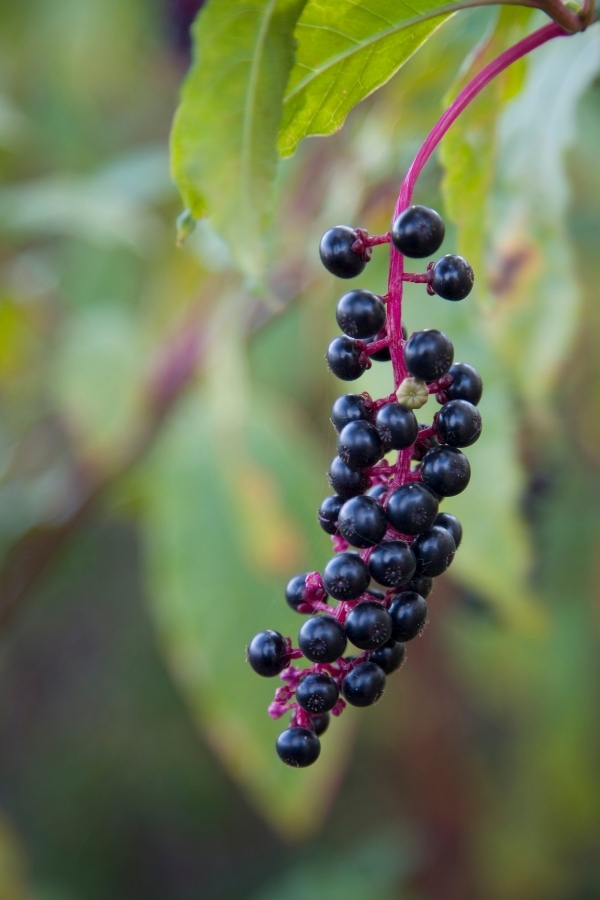
Snow Berry (Symphoricarpos sp.)
Snowberry belongs to the Honeysuckle family, and there are several different species. Common snowberry grows native in the eastern half of the United States, while wolfberry is native to the United States’ western half.
As the name suggests, this plant produces berries that are snow white. It’s sometimes called waxberry, white coralberry, or few-flowered snowberry. (Range Map)
Snowberry plants grow up to nine feet tall and thrive in dry to moist open forests, clearings, or slopes. This plant adapts well to different conditions.
It has oval leaves with smooth or wavy-toothed margins; some have hair on the leaves’ undersides. The flowers are small pink or white bells that develop in dense clusters. In the fall, white berry-like drupes appear in place of the flowers.
Snowberries are largely considered to be poisonous, but we know some Native American tribes ate them. The berries contain large amounts of saponins, which are highly toxic to animals, including fish.
Snowberries also contain isoquinoline. Ingesting these berries leads to vomiting, dizziness, and sedation in children. While these plants are a popular ornamental shrub in gardens, keep them off your property if you have kids.
Similar Edible Berries: Creeping snowberry or Moxie Plum (Gaultheria hispidula) is a similar-looking edible white berry that’s closely related to wintergreen. The plants have a somewhat different growth habit, but the berries look quite similar. Moxie plum isn’t exactly tasty, so I don’t recommend harvesting any white berries as a precaution. It’s just not worth it.
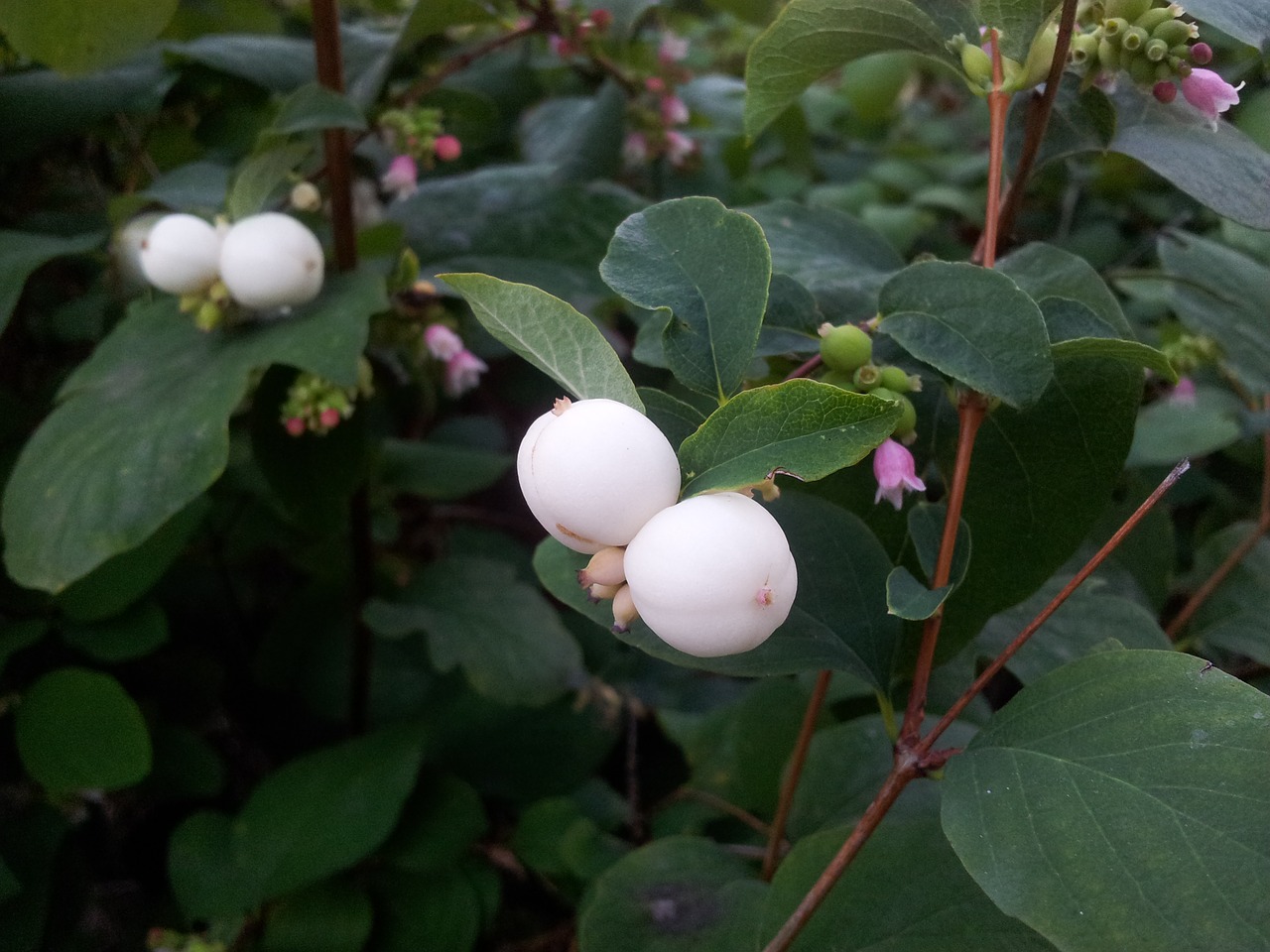
Virginia Creeper (Parthenocissus quinquefolia)
Virginia creeper is a highly toxic poisonous berry plant that goes by the names woodbine, woodbine, false grapes, thicket creeper, and five-leaved ivy. It’s often confused with eastern poisonous ivy, but the most obvious difference is that eastern poison ivy has three leaflets, and Virginia creep has five leaflets.
Virginia creeper grows throughout the eastern half of North America, stretching from Florida up to Ontario and Nova Scotia. (Range Map) You often find this plant in new and old forests, clearings, fencerows, and stream banks.
I see it everywhere, most commonly climbing telephone poles along the side of the road.
This plant is a native, perennial, woody vine that likes to climb or trail along the ground. The leaves have five leaflets, and there are green color flowers in small clusters across the plant.
In the summer, those flowers change to fruit clusters that are bluish-black berries containing two to three seeds. Typically, the flowers appear from June to August, and the fruits appear from August to October.
All parts of the Virginia creeper are toxic. There are several reports of children becoming violently ill and dying due to consumption of the berries. Its toxicity is linked to calcium oxalate, sometimes called oxalic acid. Two ounces of oxalic acid kills a human.
Similar Edible Berries: It’s possible to confuse the berries from a Virginia creeper to wild grapes. Wild grapes have a woody vine with bluish-black berries. The easiest way to tell them apart is to look at the leaves. Wild grapes have large, serrated, three-lobed leaves. I often see the two vining together, and my little ones have grabbed it when we’re out foraging wild grapes, so be very careful.

Yew Berry (Taxus sp.)
Yew trees are evergreen trees in the conifer family, and they look an awful lot like hemlock trees. While hemlock trees are edible (and have nothing to do with poison hemlock, which is more like a carrot than a tree), yew trees are incredibly toxic.
A few other names that it might be called include common yew, English yew, or European yew.
They’re commonly grown as landscape trees and hedges because they grow into a thick evergreen that’s easy to prune. The bright red berries persist all winter, and they look absolutely beautiful against the green backdrop in the winter months.
This range map only has a few locations, but I know it’s inaccurate as I see them all over the place here in Vermont. They even line State street in the Vermont capitol.
The leaves are flat needles and only one-inch in length. They look like shoots, and the seed cones have a fleshy scale that looks like a soft, bright red berry. This structure is called an aril. The aril isn’t the poisonous part; the seed is.
Technically, the “berry” itself is edible, and I’ve seen people make beautiful yew berry tarts by meticulously removing the highly toxic seeds. To me, it’s just not worth the risk, given the extreme toxicity of yew seeds.
Yew berry kills you quickly. Chewing this seed kills you by sending you into cardiac arrest.
Not only is the seed extremely poisonous, but the leaves are toxic to humans and livestock. Some of the symptoms you might experience after ingestion include difficulty walking, muscle tremors, difficulty breathing, heart failure, and coldness.
Similar Edible Berries: Yew berries have no natural edible look-alike; they’re unique. Hemlock trees look very similar (though without the berries), and I often make tea from hemlock tips. You’re not likely to confuse yew berries with another edible, but you need to watch out if you’re eating hemlock foliage.
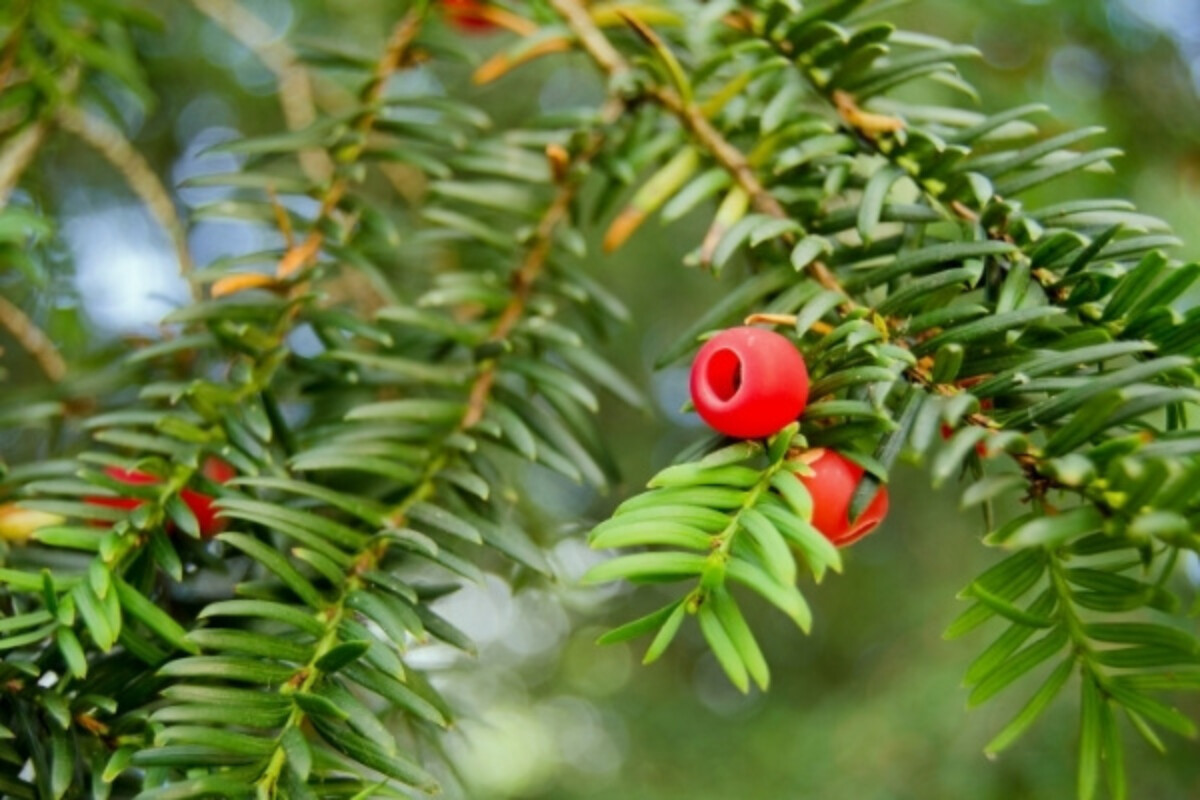
Foraging Guides
Looking for more wild edible foraging guides?
- 50+ Edible Wild Berries
- 40+ Wild Plants You Can Turn into Flour
- 16+ Medicinal Trees
- Foraging with Kids
- Foraging Morel Mushrooms
- Foraging Chanterelle Mushrooms
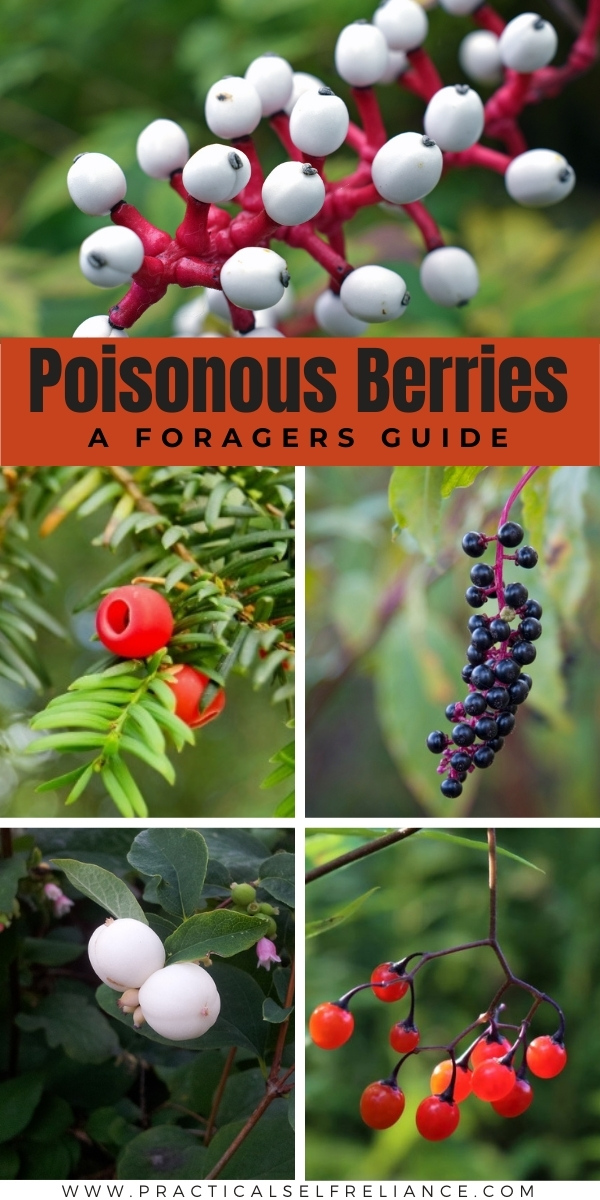














Ashley
Cottoneaster plants are toxic but the berries are still edible with low risk. They can cause a stomach ache or allergic reaction if eaten raw in large quantities, like most berries, but the fruit can be dried, used in pemmican, cooked, made into jelly etc. We use the berries from our wind break every year. The jelly has a nice apple berry cross flavor.
The presence of cyanogenic glycoside does not make a fruit or vegetable dangerous by itself anymore than the presence of the glycoalkaloid solanine makes tomatoes, potatoes, or eggplants poisonous. Cyanogenic glycosides are present in almonds, apples, bamboo shoots, cassava (tapioca), flax, lima beans, sorghum, and stone fruits among other foods . To avoid the problem completely just cook and strain the fruit to capture the seeds. It is better to advise people of risks and uses when foraging instead of just telling them the food is poisonous. This isn’t meant to be harsh and I do enjoy your content.
Thanks
Bond Eddy
Cheyenne WY
Thank you for sharing that. We appreciate it very much.
Hi, we just bought a home and the previous owners had a handful of plants and trees planted. I am having trouble identifying this tree and have pictures as it has grown. I was wondering if you could help me identify what it is, as we have a 21 month old son and the tree berries are accessible to him when they fall. I’m not sure how to send you the pictures or if you can assist.
Unfortunately there isn’t a way to upload photos here. There are some great plant identification groups on Facebook. They can sometimes be very helpful. You could also take pictures to your local nursery. Maybe they could help.
Thank you, Ashley, I have a lot, if not all of these in my woods. The red baneberry I could have; I found a lot of clusters of berries like these last fall and was excited; I thought I found ginseng! I’ll have to check the leaves next year to see.
You’re very welcome. So glad it was helpful for you.
I am here adding my vote for getting this sort of information put into a pamphlet that we could download or part of a book. I would buy either. Your info is always amazing!
So glad you enjoyed it. We don’t have a pamphlet or book at this time but you can download the page as a PDF. Just click on the three dots in the upper righthand corner of the page and click on print. When the print box pops up choose Save as PDF under the Destination drop down menu and then click save.
So , once again you are my favorite person ever (no surprise there). I was “about” to try to sit down with my kids (homeschooling) and put together this list, but I admit it has been terribly daunting which is why it had remained on my to do list for like a year…. once again you’ve saved my bacon, I will bookmark this post and use it to help us make a super cool poison plants awareness chart for the wall. (and yes, thank you so much for the captions!)
That’s great! So glad you found it helpful.
Hey Ashley! Thanks for the great article! As I was reading through it, it occurred to me that (at least to me) winterberries and buffaloberries look really, really similar. Since there’s an awful lot of one of them growing near my parents, and I’d like to get into them if they are edible, do you have any tips for distinguishing the two?
You, are such a precious young woman and I am so grateful for how much time you spend to educate us on such a vast array of plants and DYIs.
THANK YOU FOR SHARING YOUR KNOWLEDGE AND YOUR PRECIOUS TIME, A COMMODITY YOU WILL NEVER GET BACK.
God Bless and Keep you and your loved ones safe and healthy.
Thank you so much for the kind words. I am so glad you are enjoying the posts.
Hello,
Thank you for all your hard work! I was wondering if you create your articles on word and then copy and paste or if you just type into the web site.
If you work in word then you could turn your articles into pdf files. That way you would be able to make booklets that people can download. Either for free or for a small fee for having them in a printable format. At some point you will have enough guides etc. for a book that might be of interest to publishers. Just a thought.
That’s actually a great thought. I am not sure how Ashley does it. Even on the website platform, the content could easily be copied to create a document like you are suggesting. Who knows, maybe one day there will be a book. I know I would buy it.
FYI Some of the images do not have captions and I am not sure what I am looking at. For example, the image above Belladonna could be Belladona, Bittersweet or an edible look-alike of Bittersweet.
Otherwise, fantastic information as always!
Thanks for the heads up! I’ve added captions to everything.